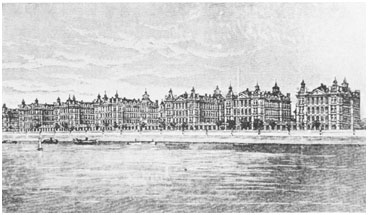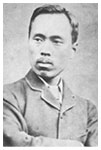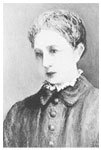





 |
 |
 |
 |

| TOP > Our Roots - To Serve the Suffering Poor |


 |
Our Roots - To Serve the Suffering Poor
The Jikei University School of Medicine had its origins in the Sei-I-Kwai
Koshujo (Sei-I-Kwai Medical Training School) founded on May ‚P, 1881, by Kanehiro
Takaki (1849-1920), who is famous for proposing the dietary theory of beriberi
and eradicating the disease from the Imperial Japanese Navy. From 1875 to 1881
Takaki studied as a naval cadet at London's Sst. Thomas's Hospital Medical School.
His experiences in London seem to have inspired him to establish a similarly authoritative
medical school in Japan some day. Soon after his return to Japan in 1881, Dr.
Takaki founded the Sei-I-Kwai Koshujo because of the rapid but undesirable changes
that he had observed in Japanese medicine.
With the declining influence in Japan of the English physician William Willis (1837-94) and the Meiji government's adoption of the German system of medicine, Japan's medical community rapidly acquired a decidedly German character. Nowhere was the German influence stronger than at the University of Tokyo, at that time the nation's only medical school.
 |
| St. Thomas's Hospital(1875) |
Hallmarks of the German system were authoritarian discipline and an emphasis on research over treatment: patients were usually regarded as objects or even as raw material for medical research. Takaki felt an urgent need to establish in Japan the more humanistic ideas of English medicine.
Together with Toan Matsuyama he founded the Sei-I-Kwai medical society in January 1881; the Koshujo (medical training school) followed in May of that year. Matsuyama and Takaki sought to change the prevailing tendency of Japanese doctors to "examine patients as research material" to one of "treating them as human beings suffering from an illness."
| The Sei-I-Kwai is still an active academic society which has, as of 2002, held 119 annual meetings and is now publishing the volume 117 issues of its official organ, the Tokyo Jikeikai Medical Journal. Its training school, the Sei-I-Kwai Koshujo, opened on May 1, 1881, and was first located at 11 Yariyacho, Kyobashi Ward (now 4-1 Ginza 4-chome, Chuo Ward). A small monument was erected there in 1981 to commemorate the centennial of the founding of The Jikei University. |
|
In 1882 Takaki and Bunkai Totsuka founded a charitable hospital called Yushi Kyoritsu Tokyo Byoin (which can be translated as "the Tokyo Hospital cooperatively founded by public-spirited persons"). It was founded with the goal of "helping those who suffer needlessly without treatment because poverty denies them timely opportunities for medical care." This attitude was in sharp contrast to that of the University of Tokyo, where charity patients were accepted, but primarily for research purposes: "The poor are to be admitted and treated free of charge when considered valuable for research." Indeed, Yushi Kyoritsu Tokyo Byoin was inclined to "turn away the well-dressed and wealthy." This spirit is thought to have derived from the strong humanitarian and philanthropic influences Takaki received while in England. The first part of the hospital's name, "Yushi Kyoritsu," reflects the donations that made its founding possible. The hospital's first president was Prince Takehito Arisugawa. Yushi Kyoritsu Tokyo Byoin also had the strong support of the Navy's medical officers, many of whom had studied in England and thus differed in almost every respect from the many Army surgeons who had studied in Germany and were closely connected with the University of Tokyo.
 |
| Kanehiro Takaki in London(1875) |
In addition to its charitable work, Yushi Kyoritsu Tokyo Byoin had a vital educational function. Students of the Sei-I-Kwai Koshujo and of the naval medical college trained there. Thus, Takaki was able to establish in Tokyo the close ties between charity and medical training that he had witnessed in England. The Meiji Empress became the hospital's president in 1887, at which time it was renamed Tokyo Jikei Iin (hospital); thereafter, its operating funds came mainly from the Imperial Household.
The medical school changed its name in 1890 from Sei-I-Kwai Koshujo to Sei-I Gakko (school) and then in 1891 to Tokyo Jikei Iin Igakko (Tokyo Jikei Hospital Medical School). The school has been in its present location, Nishi-Shimbashi 3-chome, Minato Ward (formerly Atagocho 2-chome, Shiba Ward), since 1885.
A notable feature of the Yushi Kyoritsu Tokyo Byoin was its nurse's training school, the Kangofu Kyoiku-jo. Takaki was determined to develop in Japan the kind of modern nursing training he had observed at the Nightingale Nursing School attached to St. Thomas's Hospital. In October 1884 he invited the American missionary Mary L. Reade to be the instructor for Japan's first program for modern nursing education. The first graduating class had only five students, but the Empress, as hospital president, attended the graduation ceremony.Today's Jikei Training School for Nurses (Jikei Kango Semmon Gakko) continues the tradition began over a century ago.
 |
| Miss Reade who contributed greatly to the training of nurses(1887) |
Tokyo Jikeikai, with Princess Yasuko Arisugawa (wife of Prince Takehito Arisugawa) as president, was incorporated in 1907 to provide financial support for Tokyo Jikei Iin. Accordingly, Tokyo Jikei Iin was renamed Tokyo Jikeikai Iin (Tokyo Jikeikai Hospital). Likewise, its medical school, which had already achieved status as an igaku semmon gakko (medical college), changed its name to Tokyo Jikeikai Iin Igaku Semmon Gakko (Tokyo Jikeikai Hospital Medical College). The spiritual basis of Tokyo Jikeikai is said to be the "compassionate heart" of Buddhist tradition.
With the introduction in 1921 of university reforms (extending to qualified private institutions a status previously limited to state institutions of higher education), Tokyo Jikeikai Hospital Medical College became Tokyo Jikeikai Ika Daigaku (medical university). On this occasion the Takaki family donated its privately-owned Tokyo Byoin (hospital) to the new university as its attached hospital.
With the educational reforms after the Second World War, Tokyo Jikeikai Medical University became a university in the new system (1952) and in 1956 its graduate school for medical research, offering doctoral degrees (Igaku Hakase), was approved.
|
|
|

